Sandgrouse is the common name for Pteroclididae, a family of sixteen species of bird, members of the order Pteroclidiformes. They are traditionally placed in two genera. The two central Asian species are classified as Syrrhaptes and the other fourteen species, from Africa and Asia, are placed in the genus Pterocles. They are ground dwelling birds restricted to treeless, open country, such as plains, savannahs and semi-deserts. They are distributed across northern, southern and eastern Africa, Madagascar, the Middle East and India through to central Asia.
Sandgrouse have small, pigeon-like heads and necks and sturdy compact bodies. They range in size from 24 to 40 cm in length. The adults are sexually dimorphic with the males being slightly larger and more brightly colored than the females. They have eleven strong primary feathers and long pointed wings giving them a fast direct flight. The muscles of the wings are powerful and the birds are capable of rapid take off and sustained flight. In some species, the central feathers in the tail are extended into long points. The legs are short and members of the genus Syrrhaptes have feathers growing on both the legs and toes and no hind toes, while members of the genus Pterocles have legs feathered just at the front, no feathers on the toes and rudimentary hind toes raised off the ground. The plumage is cryptic, generally being in shades of sandy brown, grey and buff, variously mottled and barred, enabling the birds to merge into the dusty landscape. There is a dense layer of under down which helps insulate the bird from extremes of heat and cold. The feathers of the belly are specially adapted for absorbing water and retaining it, allowing adults, particularly males, to carry water to chicks that may be many miles away from watering holes. The amount of water that can be carried in this way is 15 to 20 millilitres.
Sandgrouse are principally seed eaters. Sandgrouse are gregarious, feeding in flocks of up to 100 birds. As a consequence of their dry diet, they need to visit water sources regularly. Drinking times vary among the species.
Africa Wild Bird Book
Family Pteroclidae (Sandgrouse) index
Species indigenous to southern Africa:
ORDER PTEROCLIFORMES
Family Pteroclidae (Sandgrouse)
Pterocles namaqua Namaqua Sandgrouse 344
Pterocles gutturalis Yellow-throated Sandgrouse 346
Pterocles bicinctus Double-banded Sandgrouse 347
Pterocles burchelli Burchell's Sandgrouse 345
ORDER PTEROCLIFORMES
Family Pteroclidae (Sandgrouse)
Pterocles namaqua Namaqua Sandgrouse 344
Pterocles gutturalis Yellow-throated Sandgrouse 346
Pterocles bicinctus Double-banded Sandgrouse 347
Pterocles burchelli Burchell's Sandgrouse 345
- Mel
- Global Moderator
- Posts: 28260
- Joined: Sat May 19, 2012 12:31 pm
- Country: Germany
- Location: Föhr
- Contact:
Namaqua Sandgrouse
344. Namaqua Sandgrouse Pterocles namaqua (Kelkiewyn)
Order: Pteroclidiformes. Family: Pteroclididae

Male & female
Description
28 cm.
The male has an orangish buff head, throat and chest delineated by a conspicuous narrow band of white and dark brown. The back and wings are mottled brown with large white specks. Both sexes have long, pointed tails.
Adult female: Head and upper breast vertically streaked dark brown and buff; throat plain yellowish. Upper breast streaked dark brown; lower breast and belly transversely barred brown and buff.
Similar species: The Double-banded Sandgrouse female is distinguished from female Namaqua and Yellow-throated Sandgrouse by barred (not streaked) upper breast and conspicuous yellow skin around eye; female also lacks chestnut belly of female Yellow-throated Sandgrouse. It could be confused with the Double-banded Sandgrouse and Burchell's Sandgrouse, which share the same range. At rest or walking, male most resembles Double-banded Sandgrouse, but lacks the black and white bands on the forehead and has a plain (not barred) lower breast and belly.
Female and juvenile differ from female and juvenile Double-banded Sandgrouse in being more buffy yellow on the throat and breast, and in having a pointed (not rounded) tail.
Distribution
Near-endemic to southern Africa, occurring from south-western Angola through Namibia to patches of Botswana, the Northern Cape and adjacent provinces.
Habitat
Gravel desert, sandy semi-desert, open dwarf shrubland and sandy savanna.
Movements and migrations
Nomadic and partially migratory, as it is mainly present in Namaqualand and Karoo in summer (September-April) and in the southern Kalahari it is most common in winter (May-August).
Diet
It mainly eats seeds, especially of protein-rich legumes, supplemented with flowers, small fruits and fresh leaves.
Breeding
Monogamous solitary nester, it is not territorial, with both sexes selecting the nest site. Usually the nests are solitary but sometimes several pairs of birds choose sites near each other. The nest is a scrape in the earth, scantily lined with dried plant material. Egg-laying season is year-round, peaking from January-May in northern Namibia, April-July in the Namib Desert (Namibia), June-November in the Kalahari, August-January in the Nama Karoo and September-February in the Western Cape. Two or three pinkish-grey eggs with brown markings are laid over the course of a few days. Incubation starts after the last egg has been laid and lasts about 22 days. The female does the incubation by day and the male does a longer shift at night, starting about two hours before sunset and finishing two hours after dawn. The chicks are precocial and able to leave the nest on the day they are hatched and they quickly learn how to pluck seeds from the ground. The male makes daily trips to a waterhole so that he can soak his belly feathers which the young drink from, only stopping when they reach about two months old. They can fly in short burst at about 30 days old, flying strongly about 12 days later but only becoming fully independent at least a month later.
Call
A nasal kelkiewyn in flight.
Status
Common, endemic resident.
Lloyd, P. 1996. Desert nomad extraordinaire: the Namaqua Sandgrouse. Africa - Birds & Birding 1(5):26-32.
Order: Pteroclidiformes. Family: Pteroclididae

Male & female
Description
28 cm.
The male has an orangish buff head, throat and chest delineated by a conspicuous narrow band of white and dark brown. The back and wings are mottled brown with large white specks. Both sexes have long, pointed tails.
Adult female: Head and upper breast vertically streaked dark brown and buff; throat plain yellowish. Upper breast streaked dark brown; lower breast and belly transversely barred brown and buff.
Similar species: The Double-banded Sandgrouse female is distinguished from female Namaqua and Yellow-throated Sandgrouse by barred (not streaked) upper breast and conspicuous yellow skin around eye; female also lacks chestnut belly of female Yellow-throated Sandgrouse. It could be confused with the Double-banded Sandgrouse and Burchell's Sandgrouse, which share the same range. At rest or walking, male most resembles Double-banded Sandgrouse, but lacks the black and white bands on the forehead and has a plain (not barred) lower breast and belly.
Female and juvenile differ from female and juvenile Double-banded Sandgrouse in being more buffy yellow on the throat and breast, and in having a pointed (not rounded) tail.
Distribution
Near-endemic to southern Africa, occurring from south-western Angola through Namibia to patches of Botswana, the Northern Cape and adjacent provinces.
Habitat
Gravel desert, sandy semi-desert, open dwarf shrubland and sandy savanna.
Movements and migrations
Nomadic and partially migratory, as it is mainly present in Namaqualand and Karoo in summer (September-April) and in the southern Kalahari it is most common in winter (May-August).
Diet
It mainly eats seeds, especially of protein-rich legumes, supplemented with flowers, small fruits and fresh leaves.
Breeding
Monogamous solitary nester, it is not territorial, with both sexes selecting the nest site. Usually the nests are solitary but sometimes several pairs of birds choose sites near each other. The nest is a scrape in the earth, scantily lined with dried plant material. Egg-laying season is year-round, peaking from January-May in northern Namibia, April-July in the Namib Desert (Namibia), June-November in the Kalahari, August-January in the Nama Karoo and September-February in the Western Cape. Two or three pinkish-grey eggs with brown markings are laid over the course of a few days. Incubation starts after the last egg has been laid and lasts about 22 days. The female does the incubation by day and the male does a longer shift at night, starting about two hours before sunset and finishing two hours after dawn. The chicks are precocial and able to leave the nest on the day they are hatched and they quickly learn how to pluck seeds from the ground. The male makes daily trips to a waterhole so that he can soak his belly feathers which the young drink from, only stopping when they reach about two months old. They can fly in short burst at about 30 days old, flying strongly about 12 days later but only becoming fully independent at least a month later.
Call
A nasal kelkiewyn in flight.
Status
Common, endemic resident.
Lloyd, P. 1996. Desert nomad extraordinaire: the Namaqua Sandgrouse. Africa - Birds & Birding 1(5):26-32.
God put me on earth to accomplish a certain amount of things. Right now I'm so far behind that I'll never die.
- Mel
- Global Moderator
- Posts: 28260
- Joined: Sat May 19, 2012 12:31 pm
- Country: Germany
- Location: Föhr
- Contact:
Namaqua Sandgrouse Photos
344. Namaqua Sandgrouse Pterocles namaqua (Kelkiewyn)
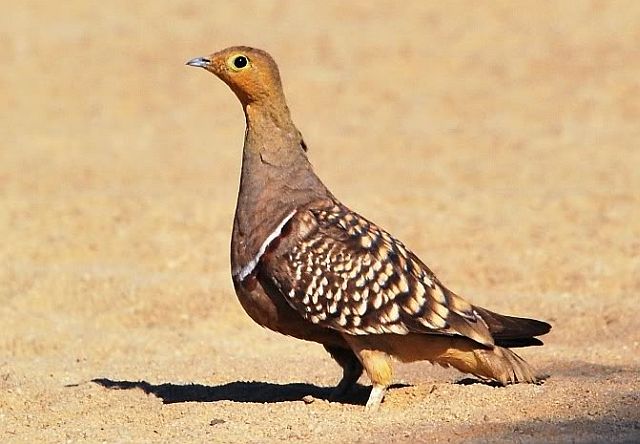
Male
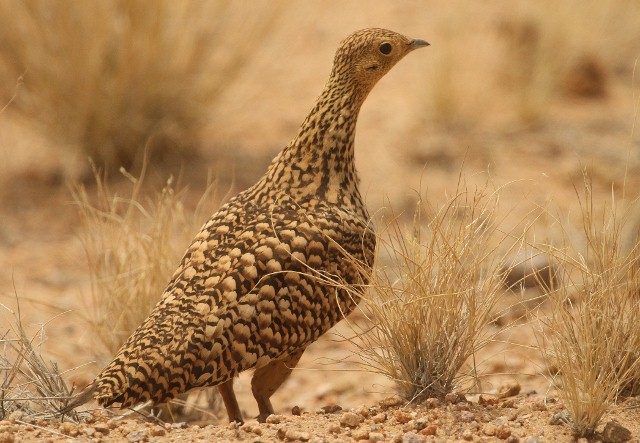 © nan
© nan
Female
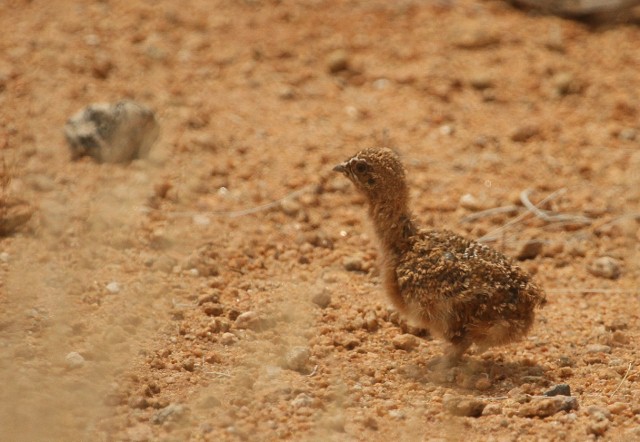 © nan
© nan
Chick
 © BluTuna
© BluTuna
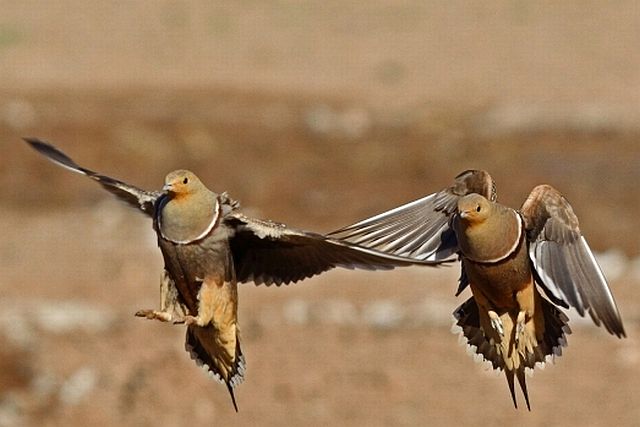 © BluTuna
© BluTuna
 © Sharifa & Duke
© Sharifa & Duke
Links:
Species text Sabap1
Sabap2
Lloyd, P. 1996. Desert nomad extraordinaire: the Namaqua Sandgrouse. Africa - Birds & Birding 1(5):26-32.

Male
 © nan
© nanFemale
 © nan
© nanChick
 © BluTuna
© BluTuna © BluTuna
© BluTuna © Sharifa & Duke
© Sharifa & DukeLinks:
Species text Sabap1
Sabap2
Lloyd, P. 1996. Desert nomad extraordinaire: the Namaqua Sandgrouse. Africa - Birds & Birding 1(5):26-32.
God put me on earth to accomplish a certain amount of things. Right now I'm so far behind that I'll never die.
Double-banded Sandgrouse
347. Double-banded Sandgrouse Pterocles bicinctus (Dubbelbandsandpatrys)
Order: Pteroclidiformes. Family: Pteroclididae

Female
Description
25-28 cm. Both sexes have an area of bare yellow skin surrounding their eye.
Male: Back, tail & wings are cryptically marked with black, white and brown. Neck, breast and barred belly are soft peach brown with distinctive black & white breast-band and forehead. Bill is orange.
Female also cryptically marked, but not as striking as the male and these markings extend to the head and underparts. Crown, nape and back and sides of neck buff with black streaks. Mantle, back, rump, tail, lower throat, breast and belly are barred blackish.
The juvenile resembles the female.
Distribution
Near-endemic to southern Africa, occurring from southern Angola, southern and eastern Zambia and marginally southern Malawi to Namibia, northern and eastern Botswana, northern and southern Botswana, Mozambique and northern South Africa.
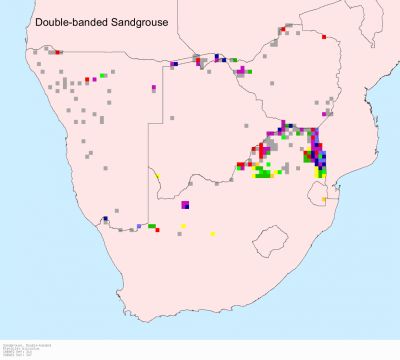
Habitat
Woodland & savanna.
Diet
It mainly eats seeds, doing most of it foraging in the early morning, late afternoon and at night.
Breeding
Monogamous, solitary nester. Breeding takes place between February and September, peaking from May-August in Namibia and Botswana and from July-September in Zimbabwe and northern South Africa. The male has a courtship display in which he walks round in circles with his beak near the ground and his tail raised high. The nest is a shallow depression in the soil, lined with a few bits of dried vegetation, often hidden between grass tufts or under a bush.
Egg-laying season is from February-September. Two or three eggs are laid and both sexes take it in turn to incubate them. They hatch in about 24 days. The chicks are precocial, being active with eyes open and clothed in fluffy down as soon as they are hatched.
Call
Soft, quick weep-weeu, chuk-chukki weep-weeu. Mostly silent in flight. Listen to Bird Call.
Status
Common, near endemic resident.
Order: Pteroclidiformes. Family: Pteroclididae

Female
Description
25-28 cm. Both sexes have an area of bare yellow skin surrounding their eye.
Male: Back, tail & wings are cryptically marked with black, white and brown. Neck, breast and barred belly are soft peach brown with distinctive black & white breast-band and forehead. Bill is orange.
Female also cryptically marked, but not as striking as the male and these markings extend to the head and underparts. Crown, nape and back and sides of neck buff with black streaks. Mantle, back, rump, tail, lower throat, breast and belly are barred blackish.
The juvenile resembles the female.
Distribution
Near-endemic to southern Africa, occurring from southern Angola, southern and eastern Zambia and marginally southern Malawi to Namibia, northern and eastern Botswana, northern and southern Botswana, Mozambique and northern South Africa.

Habitat
Woodland & savanna.
Diet
It mainly eats seeds, doing most of it foraging in the early morning, late afternoon and at night.
Breeding
Monogamous, solitary nester. Breeding takes place between February and September, peaking from May-August in Namibia and Botswana and from July-September in Zimbabwe and northern South Africa. The male has a courtship display in which he walks round in circles with his beak near the ground and his tail raised high. The nest is a shallow depression in the soil, lined with a few bits of dried vegetation, often hidden between grass tufts or under a bush.
Egg-laying season is from February-September. Two or three eggs are laid and both sexes take it in turn to incubate them. They hatch in about 24 days. The chicks are precocial, being active with eyes open and clothed in fluffy down as soon as they are hatched.
Call
Soft, quick weep-weeu, chuk-chukki weep-weeu. Mostly silent in flight. Listen to Bird Call.
Status
Common, near endemic resident.
Dewi
What is the good of having a nice house without a decent planet to put it on? (H D Thoreau)
What is the good of having a nice house without a decent planet to put it on? (H D Thoreau)
Double-banded Sandgrouse Photos
347. Double-banded Sandgrouse Pterocles bicinctus (Dubbelbandsandpatrys)
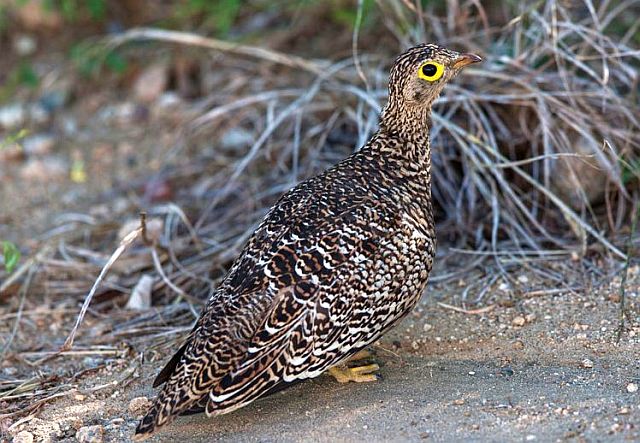 © Pumbaa
© Pumbaa
Female
 © Pumbaa
© Pumbaa
Female, Kruger National Park
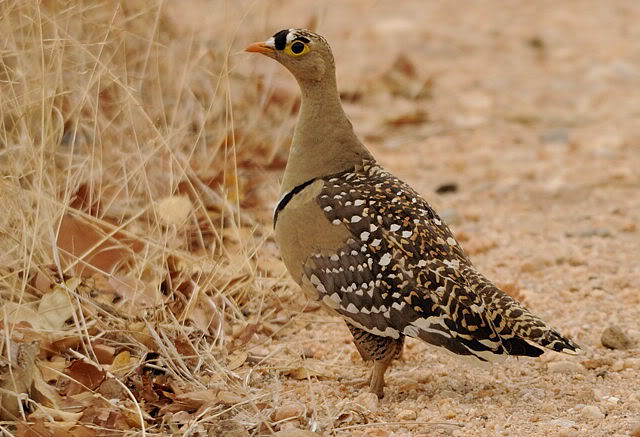
Male
 © H. erectus
© H. erectus
Male, Kruger National Park
 © harrys
© harrys
Chick, Kruger National Park
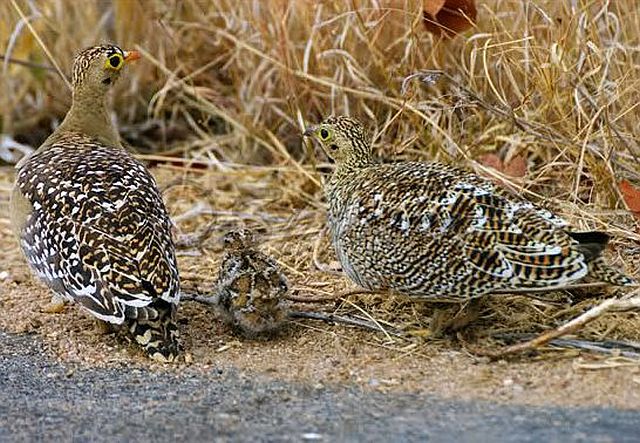 © Sprocky
© Sprocky
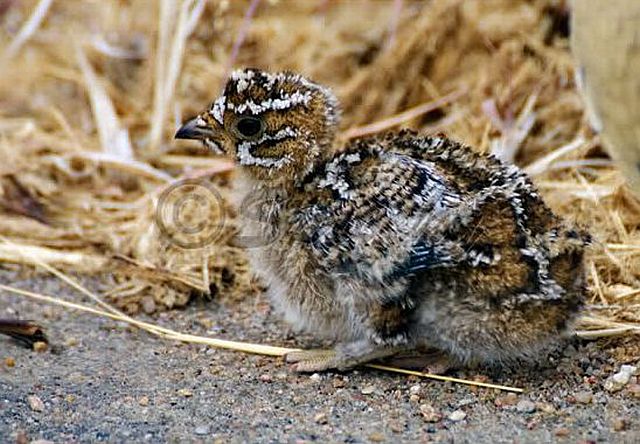 © Sprocky
© Sprocky
Links:
Sabap2
 © Pumbaa
© Pumbaa Female
 © Pumbaa
© Pumbaa Female, Kruger National Park

Male
 © H. erectus
© H. erectusMale, Kruger National Park
 © harrys
© harrysChick, Kruger National Park
 © Sprocky
© Sprocky © Sprocky
© Sprocky Links:
Sabap2
Dewi
What is the good of having a nice house without a decent planet to put it on? (H D Thoreau)
What is the good of having a nice house without a decent planet to put it on? (H D Thoreau)
Burchell's Sandgrouse
345. Burchell's Sandgrouse Pterocles burchelli (Gevlekte Sandpatrys)
Order: Pteroclidiformes. Family: Pteroclididae
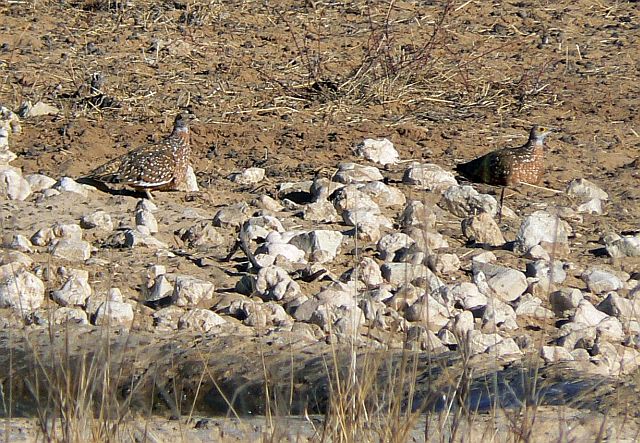
Kgalagadi Transfrontier Park, Samevloeiing
Description
Length 25 cm, weight 160-200 g. Burchell's Sandgrouse is a plump bird about the size of a pigeon with a small head and short legs. The eye is surrounded by bare yellow skin, the cheeks and throat are pale grey and the body is light brown, mottled with darker shades and white speckles. Salmon-rufous underparts with bold white spots distinctive. The bill is coloured black. It has yellow legs. The eyes are brown. The white-spotted cinnamon breast and belly, combined with the white- spotted back and wing coverts, render this small sandgrouse unmistakable.
Sexes similar. Males larger than females. Males with grey faces and females yellowish. Females lack the blue-grey throat and are drabber in coloration.
Juvenile is similar to female with duller white spots.
Distribution
Near-endemic to southern Africa, occurring from south-eastern Angola to Namibia (excluding the most arid areas closer to the coast), Botswana and northern South Africa.
Habitat
It generally prefers areas with red Kalahari sands with patches of grass and scattered shrubs.
Diet
It mainly eats seeds, especially of legumes, doing most of its foraging in pairs or small flocks during the day.
Breeding
Monogamous solitary nester, with a simple nest consisting of a scrape in sandy soil, sparsely lined with dry plant material and typically placed next to a grass tuft or shrub. Egg-laying season is in the dry winter months, from April-October. It lays three, rarely two eggs. There is little information regarding the chicks, however it is likely that the development and care of the young is similar to that of other sandgrouse, with the female gathering water for its young in its belly feathers and both parents accompanying their young when they leave the nest.
Call
A soft, mellow chup-chup-choop-choop given in flight and around waterholes.
Status
Locally common near-endemic. Flocks to drink, usually 2-3 hours after sunrise.
Order: Pteroclidiformes. Family: Pteroclididae

Kgalagadi Transfrontier Park, Samevloeiing
Description
Length 25 cm, weight 160-200 g. Burchell's Sandgrouse is a plump bird about the size of a pigeon with a small head and short legs. The eye is surrounded by bare yellow skin, the cheeks and throat are pale grey and the body is light brown, mottled with darker shades and white speckles. Salmon-rufous underparts with bold white spots distinctive. The bill is coloured black. It has yellow legs. The eyes are brown. The white-spotted cinnamon breast and belly, combined with the white- spotted back and wing coverts, render this small sandgrouse unmistakable.
Sexes similar. Males larger than females. Males with grey faces and females yellowish. Females lack the blue-grey throat and are drabber in coloration.
Juvenile is similar to female with duller white spots.
Distribution
Near-endemic to southern Africa, occurring from south-eastern Angola to Namibia (excluding the most arid areas closer to the coast), Botswana and northern South Africa.
Habitat
It generally prefers areas with red Kalahari sands with patches of grass and scattered shrubs.
Diet
It mainly eats seeds, especially of legumes, doing most of its foraging in pairs or small flocks during the day.
Breeding
Monogamous solitary nester, with a simple nest consisting of a scrape in sandy soil, sparsely lined with dry plant material and typically placed next to a grass tuft or shrub. Egg-laying season is in the dry winter months, from April-October. It lays three, rarely two eggs. There is little information regarding the chicks, however it is likely that the development and care of the young is similar to that of other sandgrouse, with the female gathering water for its young in its belly feathers and both parents accompanying their young when they leave the nest.
Call
A soft, mellow chup-chup-choop-choop given in flight and around waterholes.
Status
Locally common near-endemic. Flocks to drink, usually 2-3 hours after sunrise.
Burchell's Sandgrouse Photos
345. Burchell's Sandgrouse Pterocles burchelli (Gevlekte Sandpatrys)
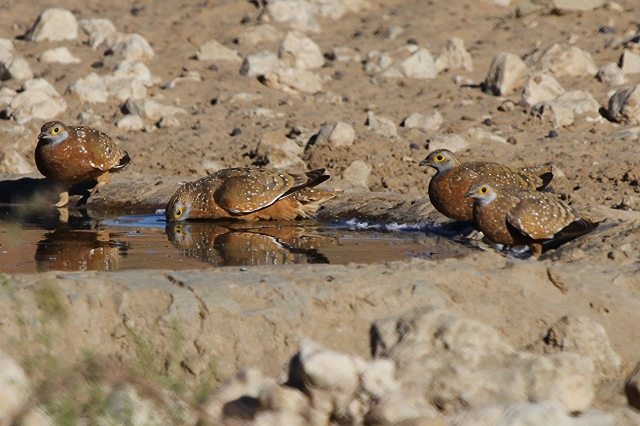 © Tina
© Tina
Leeudril, Kgalagadi Transfrontier Park
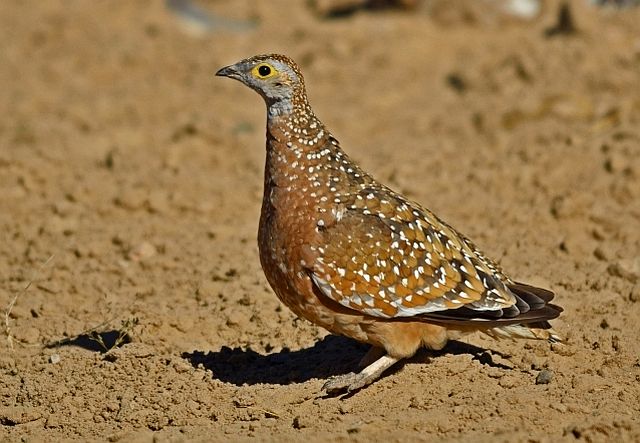 © BluTuna
© BluTuna
Male
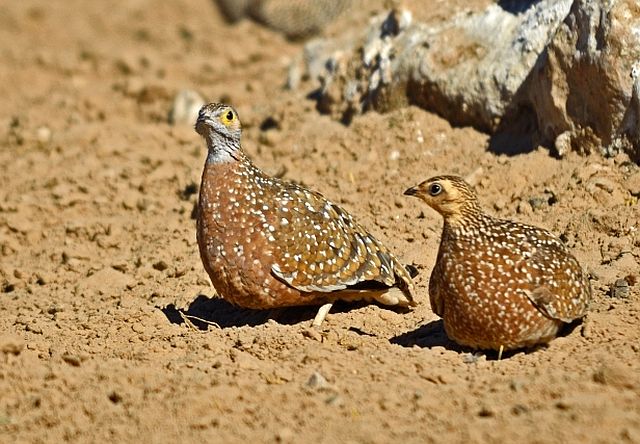 © BluTuna
© BluTuna
 © Mel
© Mel
Links:
Species text Sabap1
Sabap2: http://sabap2.adu.org.za/spp_summary.ph ... §ion=3
Google Book: Beat about the Bush: Birds, Trevor Carnab
Newman's birds of Southern Africa: Sandgrouse Identification
 © Tina
© TinaLeeudril, Kgalagadi Transfrontier Park
 © BluTuna
© BluTunaMale
 © BluTuna
© BluTuna © Mel
© MelLinks:
Species text Sabap1
Sabap2: http://sabap2.adu.org.za/spp_summary.ph ... §ion=3
Google Book: Beat about the Bush: Birds, Trevor Carnab
Newman's birds of Southern Africa: Sandgrouse Identification
ORDER COLUMBIFORMES Family Columbidae (Pigeons, Doves)
ORDER COLUMBIFORMES Family Columbidae (Pigeons, Doves)
Columbiformes are divided into two groups, the Raphidae (an extinct group of flightless birds that included the dodo) and the Columbidae (the group that includes all living pigeons and doves).
Pigeons and doves constitute the bird family Columbidae, that includes about 310 species. They are stout-bodied birds with short necks, and have short, slender bills with fleshy ceres. Doves feed on seeds, fruits, and plants. This family occurs worldwide, but the greatest variety is in the Indomalaya and Australasia ecozones.
In general, the terms "dove" and "pigeon" are used somewhat interchangeably. In ornithological practice, "dove" tends to be used for smaller species and "pigeon" for larger ones, but this is in no way consistently applied.
Doves and pigeons build relatively flimsy nests from sticks and other debris, which may be placed in trees, on ledges, or on the ground, depending on species. They lay one or two eggs, and both parents care for the young, which leave the nest after seven to 28 days.[3] Unlike most birds, both sexes of doves and pigeons produce "crop milk" to feed to their young, secreted by a sloughing of fluid-filled cells from the lining of the crop. Young doves and pigeons are called "squabs".
Overall, the Columbidae tend to have short bills and legs, and small heads on large compact bodies. The wings are large and have low wing loadings; pigeons have strong wing muscles (wing muscles comprise 31–44% of their body weight) and are among the strongest fliers of all birds. They are also highly manoeuverable in flight.
The plumage of the family is variable. Granivorous species tend to have dull plumage, with a few exceptions, whereas the frugivorous species have brightly coloured plumage. Pigeons and doves may be sexually monochromatic or dichromatic. In addition to bright colours, pigeons may sport crests or other ornamentation.
The family has adapted to most of the habitats available on the planet. The largest number of species is found in tropical forests and woodlands.
Seeds and fruit form the major component of the diets of pigeons and doves. In fact, the family can be divided into the seed-eating or granivorous species (subfamily Columbinae) and the fruit- and mast-eating or frugivorous species (the other four subfamilies). The granivorous species typically feed on seed found on the ground, whereas the frugivorous species tend to feed in trees. There are morphological adaptations that can be used to distinguish between the two groups, granivores tend to have thick walls in their gizzards, whereas the frugivores tend to have thin walls. In addition, fruit-eating species have short intestines, whereas those that eat seeds have longer ones. Frugivores are capable of clinging to branches and even hang upside down to reach fruit.
Links:
Africa Wild Bird of the Month February 2014: Pigeons and Doves
Columbiformes are divided into two groups, the Raphidae (an extinct group of flightless birds that included the dodo) and the Columbidae (the group that includes all living pigeons and doves).
Pigeons and doves constitute the bird family Columbidae, that includes about 310 species. They are stout-bodied birds with short necks, and have short, slender bills with fleshy ceres. Doves feed on seeds, fruits, and plants. This family occurs worldwide, but the greatest variety is in the Indomalaya and Australasia ecozones.
In general, the terms "dove" and "pigeon" are used somewhat interchangeably. In ornithological practice, "dove" tends to be used for smaller species and "pigeon" for larger ones, but this is in no way consistently applied.
Doves and pigeons build relatively flimsy nests from sticks and other debris, which may be placed in trees, on ledges, or on the ground, depending on species. They lay one or two eggs, and both parents care for the young, which leave the nest after seven to 28 days.[3] Unlike most birds, both sexes of doves and pigeons produce "crop milk" to feed to their young, secreted by a sloughing of fluid-filled cells from the lining of the crop. Young doves and pigeons are called "squabs".
Overall, the Columbidae tend to have short bills and legs, and small heads on large compact bodies. The wings are large and have low wing loadings; pigeons have strong wing muscles (wing muscles comprise 31–44% of their body weight) and are among the strongest fliers of all birds. They are also highly manoeuverable in flight.
The plumage of the family is variable. Granivorous species tend to have dull plumage, with a few exceptions, whereas the frugivorous species have brightly coloured plumage. Pigeons and doves may be sexually monochromatic or dichromatic. In addition to bright colours, pigeons may sport crests or other ornamentation.
The family has adapted to most of the habitats available on the planet. The largest number of species is found in tropical forests and woodlands.
Seeds and fruit form the major component of the diets of pigeons and doves. In fact, the family can be divided into the seed-eating or granivorous species (subfamily Columbinae) and the fruit- and mast-eating or frugivorous species (the other four subfamilies). The granivorous species typically feed on seed found on the ground, whereas the frugivorous species tend to feed in trees. There are morphological adaptations that can be used to distinguish between the two groups, granivores tend to have thick walls in their gizzards, whereas the frugivores tend to have thin walls. In addition, fruit-eating species have short intestines, whereas those that eat seeds have longer ones. Frugivores are capable of clinging to branches and even hang upside down to reach fruit.
Links:
Africa Wild Bird of the Month February 2014: Pigeons and Doves
Family Columbidae (Pigeons, Doves) Index
ORDER COLUMBIFORMES
Family Columbidae (Pigeons, Doves)
Columba livia Rock Dove 348
Columba guinea Speckled Pigeon 349
Columba arquatrix African Olive Pigeon 350
Columba delegorguei Eastern Bronze-naped Pigeon 351
Columba larvata Lemon Dove 360
Streptopelia turtur European Turtle Dove 919
Streptopelia decipiens Mourning Collared Dove (African Mourning Dove) 353
Streptopelia semitorquata Red-eyed Dove 352
Streptopelia capicola Cape Turtle Dove, Ring-necked Dove 354
Spilopelia senegalensis Laughing Dove 355
Turtur chalcospilos Emerald-spotted Wood Dove 358
Turtur afer Blue-spotted Wood Dove 357
Turtur tympanistria Tambourine Dove 35
Oena capensis Namaqua Dove 356
Treron calvus African Green Pigeon 361
Family Columbidae (Pigeons, Doves)
Columba livia Rock Dove 348
Columba guinea Speckled Pigeon 349
Columba arquatrix African Olive Pigeon 350
Columba delegorguei Eastern Bronze-naped Pigeon 351
Columba larvata Lemon Dove 360
Streptopelia turtur European Turtle Dove 919
Streptopelia decipiens Mourning Collared Dove (African Mourning Dove) 353
Streptopelia semitorquata Red-eyed Dove 352
Streptopelia capicola Cape Turtle Dove, Ring-necked Dove 354
Spilopelia senegalensis Laughing Dove 355
Turtur chalcospilos Emerald-spotted Wood Dove 358
Turtur afer Blue-spotted Wood Dove 357
Turtur tympanistria Tambourine Dove 35
Oena capensis Namaqua Dove 356
Treron calvus African Green Pigeon 361


